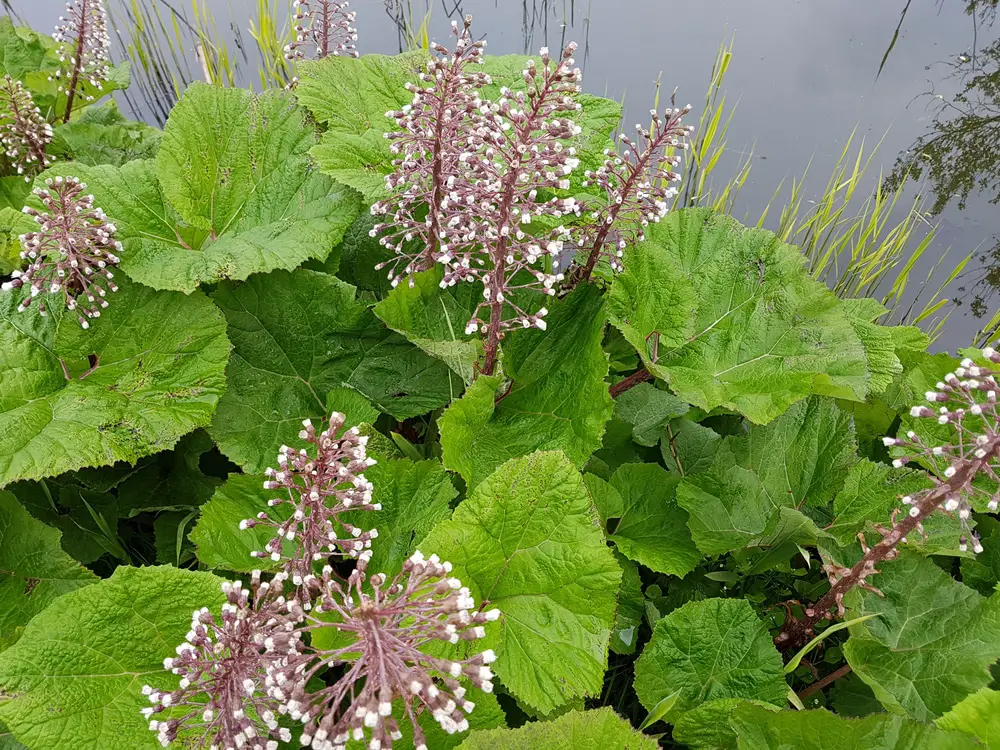Butterbur is a common name for a creeping ground plant belonging to the Petasites genus.
It is closely related to sunflowers but has its own structure and unique combinations of phytochemicals that makes it a well-respected and sought after medicinal plant.
Butterbur has amazing health benefits and some of them are its ability to reduce inflammation, fever, treat migraines, soothe pains, eliminate spasms, calm allergic reactions, and clear the respiratory tract.
Powerful alkaloids and other plant compounds can be extracted from the leaves, stems, and rhizomes of this plant and used for a variety of health conditions.
Butterbur has been used in Europe for more than 2,000 years and it is presently found on three continents: North America, Europe, and many Northern parts of Asia.
Nutritional Profile Of Butterbur
100 grams of butterbur contains:
- 94.5 grams of water
- 59 KJ of energy
- 0.39 grams of protein
- 0.04 grams of total lipid
- 1.46 grams of ash
- 3.61 grams of carbohydrates
- 103 mg of calcium
- 0.1 mg of iron
- 14 mg of magnesium
- 12 mg of phosphorous
- 655 mg of potassium
- 7 mg of sodium
Other names for butterbur are:
- Petasites japonicus,
- Fuki,
- Japanese sweet coltsfoot,
- Bog rhubarb
- Giant butterbur
Incredible Health Benefits Of Butterbur
Relieves inflammation
This is one of the most important benefits of butterbur. It has an immediate effect on reducing inflammation. Chronic inflammation is behind killer diseases like cancer, heart disease, and others.
It wears out your body gradually. For people who suffer from heart conditions or gout, this powerful anti-inflammatory herb will reduce the pain they feel.
It offers quick relief and also makes people healthy in the long-term.
Reduce sugar levels
Butterbur has an impressive amount of manganese and this essential mineral has been proven to control the levels of glucose in humans effectively.
It prevents and treats diabetes by improving the synthesis and secretion of insulin. This herb improves the daily life of diabetics.
Treats common cold
Butterbur is an expectorant. It promotes the expulsion of phlegm and mucus from the respiratory system and nose. Mucus and phlegm makes it possible for bad bacteria to hide and cause problems.
Eliminating mucus will prevent you from falling ill, hasten healing, and improve your long-term health.
Increases energy
Copper, an important mineral that plays two critical roles in energy production is present in butterbur. Firstly, copper combines with iron in the red blood cells and prevent blood shortage or anemia.
Secondly, copper generates energy from the carbohydrates inside your cells. This is why copper deficiency is similar to iron deficiency in symptoms felt.
Richest sources of copper and iron in nature are sesame seeds, lentils, etc.
Relieves allergic reactions
Allergic reactions can range from mild to severe with a variety of symptoms like dry and itchy eyes, severe sneezing, etc.
These are signs that the histamines released in your body has come across a certain substance (even though it might be harmless). Butterbur is a natural anti-histamine that can prevent and treat allergic reactions.
It also reduces the severity of the symptoms felt.
Prevents PMS
Premenstrual syndrome affects a lot of women of reproductive age and one of the beneficial herbs for this condition is butterbur. It is rich in calcium and this helps in reducing PMS symptoms like depression, mood swings, dizziness, hypertension, etc.
Low levels of calcium leads to hormonal imbalance which can trigger symptoms of PMS like depression, irritability, and mood swings.
Relieves headaches
This is the most common use of butterbur. It is used to treat migraines and headaches. It is relied on to relieve headaches in traditional medicines around the world.
Two phytochemicals responsible for reducing the severity, duration, and symptoms of migraines are Petasin and Isopetasin. They are found in butterbur.
Beneficial for the thyroid gland
Copper plays an important role in ensuring that your thyroid glands function properly and butterbur is rich in copper. Although, extra copper can trigger thyroid issues, it is hard to get excess copper from consuming butterbur.
So, maintaining the right amount of copper in your bloodstream will prevent thyroid problems (hypothyroidism and hyperthyroidism) and improve your overall health.
Reduces high temperatures
Butterbur is an effective home remedy for fever. It is used in alternative medicine to break fevers and speed up the healing process after an illness.
This is due to the anti-inflammatory nature of this herb and it is also a powerful immune booster.
Treats high blood pressure
Many studies have shown that vitamin B6 reduces high blood pressure and butterbur has a good amount of this. Vitamin B6 boosts blood flow and prevents cardiovascular diseases.
Prevents asthma
People with chronic asthma experience breathlessness and this can be relieved by increasing your intake of magnesium. Butterbur is rich in magnesium.
This mineral relaxes your bronchial muscles and help to regulate your breathing. In severe cases, breathlessness and wheezing can be relieved by the administration of intravenous magnesium.
Relieves spasms and pains
This herb has analgesic and anti-spasmodic properties. This makes it useful in treating irritable bowel syndrome, chronic pains, tremors, and injuries.
Boosts the immune system
The selenium in this potent herb helps the immune system function properly. It even helps to counteract immune deficiencies like HIV. Selenium slows the progression of HIV into AIDS.
Promotes skin care
Apply butterbur extract topically on ulcerations and wounds to relieve redness and swellings. The anti-inflammatory property helps heal injured skin.
Another way to use butterbur for skin problems is to soak a cloak in butterbur tea or extract and use as a poultice. Apply this to the affected skin part.
How to Use Butterbur as Medicine

You can find butterbur in a variety of formulas like teas, tinctures, powders, and capsules. There are lots of patented butterbur extracts like Petadolex which has at least 15% petasins and used in a lot of studies involving migraines.
If you choose to use butterbur supplements, go for those that are approved and PA-free.
If you choose to use the root of this plant, boil just a little quantity in water and leave it to simmer for 10 minutes. After this, your tea is ready for drinking.
Note that the rhizome and roots have higher concentrations of alkaloids making them very toxic when consumed excessively. This is why the leaves and stems are used more often than the roots.
The leaves, sprouts, and stems are much safer to be taken as tea than the rots. When buying your butterbur extract, make sure you buy from reputable health store to be sure of the quality and purity.
How to Consume Butterbur?
The shoots of this herb can be chopped and stir fried with miso to make the fuki-miso. This is spread thinly over hot rice and consumed. The bulb-like shoots are picked fresh and fried as tempura.
In Korea, butterbur is boiled or steamed and pressed to remove water. Perilla oil or sesame oil is added to make namul. The leaf stalks are cooked and used as rhubarb.
The stems are also boiled and seasoned, pickled and used to make winter soup. It can also be preserved in miso. The flower buds are used to cook and flavor food.
The stems of butterbur are boiled, dipped in cold water, and then peeled and baked. It has a pleasing aroma.
Precautions and Side Effects
Butterbur contains pyrrolizidine alkaloids (PAs) and high concentrations have been implicated in causing liver damage and tumors. Excess butterbur can cause gastrointestinal problems, drowsiness, itchy eyes, fatigue, asthma, headache, and belching.
Butterbur can cause allergic reactions in people who are sensitive to plants like chrysanthemums, marigolds, ragweed, and daisy.
Aside this, studies have shown that even children and adults can consume PA-free butterbur products. They are safe and well-tolerated when taken orally in the recommended daily dose for 16 weeks.
Pregnant and breastfeeding women should avoid this herb. If on any medication, consult with your doctor first before taking butterbur.
We hope you’ve learnt a lot about this wonderful herb by reading this post. What else do you know about butterbur? Please let us know in the comment section.
Sources;












